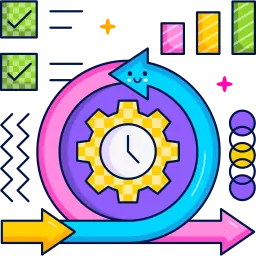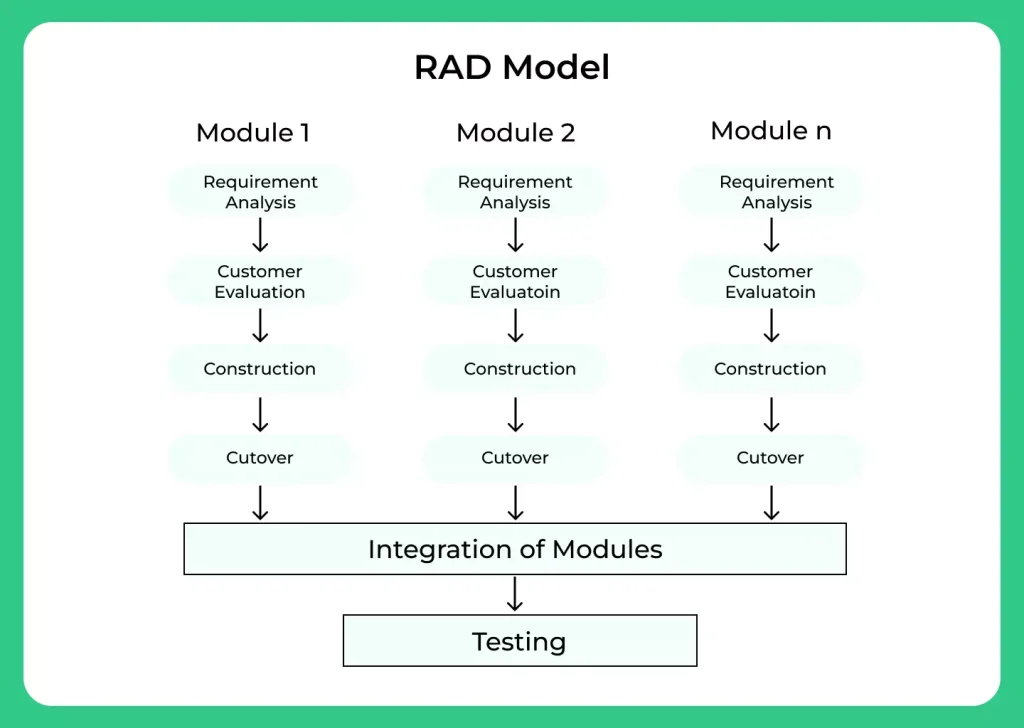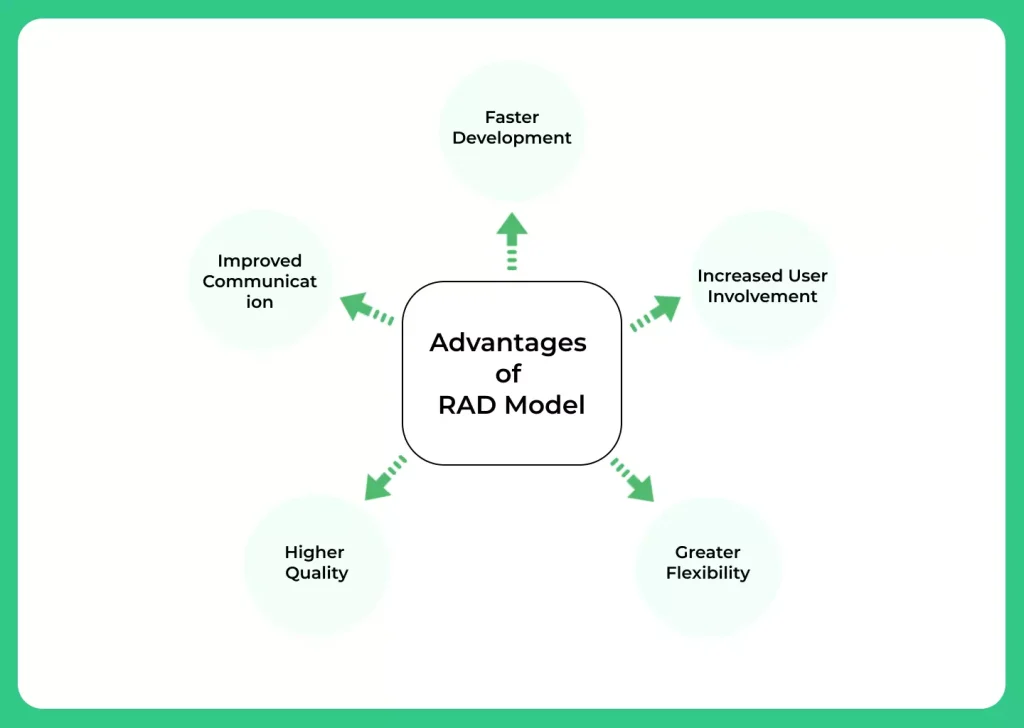RAD Model in SDLC
What is RAD Model in SDLC?
RAD Model in SDLC stands for Rapid Application Development Model. The Rapid Application Development (RAD) model is a software development methodology that focuses on rapid prototyping and fast development cycles. It was developed in the 1980s as a response to the traditional Waterfall model, which was seen as too slow and inflexible for some types of software projects.
The RAD model is an iterative and incremental approach that emphasizes rapid prototyping and rapid delivery of a working software product. It involves breaking the development process into smaller, manageable pieces and working on them in parallel.

Outline
Processes involved in RAD Model

The RAD model follows a set of steps that are designed to be completed in an iterative and incremental manner:
Identify the problem or opportunity:
The first step in the RAD process is to identify the problem or opportunity that the software will address. This step involves gathering and analyzing data, conducting market research, and defining the scope of the project.
Define the requirements:
In this step, the project team works with the customer to identify and document the specific requirements for the software. This includes gathering information about the target users, the business goals of the project, and the functional and non-functional requirements of the software.
Build the prototype:
Based on the requirements defined in the previous step, the team builds a functional prototype of the software. This prototype should be a working version of the software that demonstrates the core features and functionality of the final product.
Test and refine the prototype:
Once the prototype has been built, it is tested and refined based on feedback from the customer and end users. This step involves identifying and fixing any issues or bugs that are discovered during testing, and adding or modifying features as needed to improve the user experience.
Deliver the final product:
After the prototype has been tested and refined, the final version of the software is delivered to the customer. This step may involve additional testing and quality assurance processes to ensure that the software is ready for production use.
When to use RAD Model in SDLC?
When to Use the RAD Model:
- Quick Development: Use RAD (Rapid Application Development) when you need to build software quickly.
- Flexible Requirements: Ideal if project requirements might change often.
- User Feedback: Great for projects where user input is needed throughout the development.
- Prototyping: Best when creating prototypes to test ideas before finalizing the product.
- Team Collaboration: Suitable if you have a team that can work closely together.
Applications of RAD Model in SDLC
Following are the applications of RAD Model:
Software Prototyping:
RAD helps quickly build and test software prototypes, allowing for early user feedback and rapid adjustments.
Business Applications:
It’s useful for creating business tools that might need changes based on user needs or market trends.
Web Development:
Ideal for developing websites where requirements might change frequently or need quick updates.
Mobile Apps:
Works well for mobile apps that require fast iterations based on user feedback and changing requirements.
Small to Medium Projects:
RAD is effective for projects where speed and the ability to adapt to changes are crucial.
Advantages of RAD Model in SDLC
The Rapid Application Development (RAD) model is a software development methodology that focuses on rapid prototyping and rapid delivery of working software. Some of the key advantages of the RAD model are:

Faster development:
The focus on rapid prototyping and delivery allows developers to quickly produce working software, reducing the overall time required for development.
Increased user involvement:
The RAD model involves close collaboration with the end-users of the software, which can lead to a better understanding of their needs and requirements, resulting in a more user-friendly product.
Greater flexibility:
The RAD model allows for changes and modifications to be made throughout the development process, making it easier to adapt to changing requirements or priorities.
Higher quality:
The rapid prototyping and iteration process in the RAD model allows developers to identify and fix defects early on in the development process, leading to a higher quality product.
Improved communication:
The close collaboration between developers and end-users in the RAD model can improve communication and facilitate a better understanding of the project goals and requirements.
Customer involvement are needed.
There are no reusable component are used to lead the failure of the project.
This model works only when the requirements are clearly specified.
This model can be more complex if prototype is refined again and again.
RAD model is not suitable for the short projects.
TO wrap it up:
The RAD model is a great choice when you need to develop software quickly and adapt to changing needs. Its focus on rapid prototyping and user feedback makes it ideal for projects where flexibility and speed are important. By using RAD, you can create effective solutions that meet user requirements and adjust as needed, ensuring a successful and efficient development process.
FAQ's
The RAD model is best used when the project needs to be developed quickly, requirements are well understood, and there is active user involvement. It’s ideal for small to medium-sized projects where changes are expected during development.
The key phases of the RAD model include:
- Business Modeling
- Data Modeling
- Process Modeling
- Application Generation
- Testing and Turnover
While effective for many projects, RAD has some limitations:
- Requires active user participation
- Not suitable for large or complex projects
- Difficult to implement with inexperienced teams
- High dependency on modeling and prototyping tools
Some advantages of the RAD model include:
- Faster development and delivery
- Continuous user involvement and feedback
- Reduced development and testing time
- Flexibility to make changes during the development cycle


